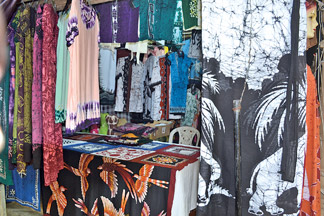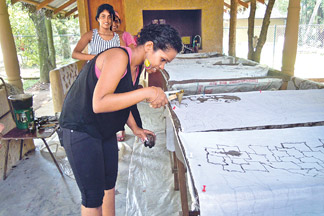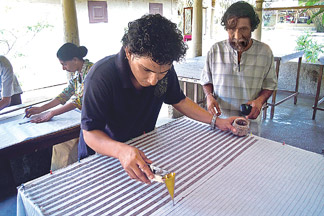|

Brighter future for batik industry
By Ananda KANNANGARA
Sri Lankan batik industry has a history of over 400 years. History
reveals that Sri Lankan villagers have been engaged in the batik
industry from the time the Portuguese arrived in the country. It is said
that batik was introduced by Portuguese merchants who visited the
country for trade activities. Even in Portugal people were engaged in
batik manufacturing industry. The industry was thereafter expanded to
the maximum during the British colonial era which ended in 1948.
 The local batik industry showed a significant improvement during the
early part of 1980 with the introduction of the Open Economy in Sri
Lanka. The local batik industry showed a significant improvement during the
early part of 1980 with the introduction of the Open Economy in Sri
Lanka.
During the colonial era when thousands of British nationals were in
the country, many villages in the south and in the hill capital of Kandy
were engaged in the batik painting industry. British merchants purchased
large quantity of batik products for the foreign market. This helped
local villagers to produce more and more batik creations and also to
have a good income.
The book on `Traditional Batik in Sri Lanka', written by a famous
batik manufacturer of Ambalangoda in the south, Gunasiri Silva says that
colonial rulers who were in the country for several decades encouraged
local villagers to develop the batik industry and to produce quality
batik garments for their market.
The local manufacturers produced batik wall hangings, frocks,
kimonas, shirts, sarongs, bed sheets, curtains, kaftans and housecoats.
The foreigners used batik products not only to beautify their
official attire, but also to decorate their bungalows.
At present the batik industry is effectively carried out in places
such as Kandy, Kegalle, Yakkala, Kadawatha, Imbulgoda, Nittambuwa,
Beruwala and some places along the Kandy Road, while batik is also
produced in Hikkaduwa, Kalutara, Beruwala, Ambalangoda on the Galle
Road.
The industry is also carried out at several ancient cities in the
country such as Anuradhapura, Polonnaruwa and Sigiriya where foreign
tourists visit very often.
 Latest statistics reveal that a large number of batik shops were
opened along the main Colombo- Katunayaka road during the past 20 years
to cater to foreign tourists who travel between Colombo and Katuanyaka
Airport. Latest statistics reveal that a large number of batik shops were
opened along the main Colombo- Katunayaka road during the past 20 years
to cater to foreign tourists who travel between Colombo and Katuanyaka
Airport.
Due to the high demand for batik garments after 1980, manufacturers
started small scale batik workshops as well as batik showrooms in many
parts of the country. The industry was further expanded after 1990 due
to the increased demand for local batiks from foreign buyers, especially
from the USA, UK, France and Japan.
When foreign tourists made their frequent visits to the country
during the latter part of year 2000, many villagers started batik
workshops in their homes as self employment ventures.
Current statistics reveal that over 200,000 people, especially
females are engaged in the batik industry all over the country.
In addition, small scale industrialists opened batik workshops and
showrooms in rural areas and supplied the products to large scale buyers
in Colombo and other main cities.
The Government too identified the increasing demand from foreign
tourists for batiks and many other traditional handicraft items and
opened a handicrafts village at Battaramulla Janakala Kendraya to enable
foreign and local visitors to purchase handicraft items under one roof.
According to batik manufacturers, the names of Vipula Batiks, Buddhi
Batiks and Saliya Batiks are still famous in the field of batik
garments.
The Sunday Observer last week visited a number of batik workshops and
showrooms in Kandy Road, Negombo Road and Galle Road to discuss with
persons engaged in the industry about the development of their business
activities, their proposals and also their grievances.
 According to some small scale batik manufacturers, the industry will
not last long unless authorities take measures to reduce the high cost
of raw materials such as dye and wax which are the most necessary
components for the batik industry. According to some small scale batik manufacturers, the industry will
not last long unless authorities take measures to reduce the high cost
of raw materials such as dye and wax which are the most necessary
components for the batik industry.
A long standing batik manufacturer and a showroom owner at Hikkaduwa,
46 year old, Ruwan Gamage said he has been in the industry for the past
28 years and wants the Government to implement a scheme to supply wax
and dye at reduced prices to batik manufacturers.
He also proposed the officials in the Ministry of Small Industries to
register countrywide all batik manufacturers under provincial level as
it will highly benefit persons involved in the industry.
The owner of Sumathi Batiks at Kalagedihena on Kandy Road, Gayantha
Caldera said around 20 persons are employed in his factory and each
person is drawing a monthly salary of Rs. 20,000.
He said the cost of raw materials such as wax and dye that are used
to manufacture batik garments are very high in the open market and
proposed the Government to provide these items at low prices through
Co-operative shops.
He said unlike earlier, now locals hardly use batik garments, but
foreigners from Western countries still prefer our batiks. Therefore, we
will have to produce batiks for the foreign market.
Batik manufacturer Sirisena Peiris (57) of Kalutara proposed the
Government to conduct batik garment exhibitions very often in Colombo
for the benefit of people engaged in the industry.
He said many small scale batik manufacturers are very poor and
proposed the authorities to introduce a bank loan scheme to develop the
industry.
He also said the Minister of Traditional Industries and Small
Enterprise Development Douglas Devananda once assured that he would help
batik manufacturers to send their products to foreign countries, but
nothing had happened so far.
 The owner of a batik showroom at Janakala Kendra, Battaramulla ,
Nimali Kodagoda proposed the authorities to send tour groups to the
Janakala Kendra complex, so that small scale manufacturers could sell
their products to foreigners. The owner of a batik showroom at Janakala Kendra, Battaramulla ,
Nimali Kodagoda proposed the authorities to send tour groups to the
Janakala Kendra complex, so that small scale manufacturers could sell
their products to foreigners.
A batik manufacturer Wijaya Kamal wants the Government to establish a
batik sales centre at the Bandaranaike Airport for the benefit of small
scale batik manufacturers to sell their products to foreigners.
Gemunu Kohona of Sakviti Batiks in Negombo said Minister Devananda
should meet batik manufacturers every so often and listen to their
grievances, so that the Minister could encourage manufacturers and get a
clear understanding of their problems.
A longstanding batik manufacturer of Nittambuwa, Kosala Haripriya of
`Kosala Batiks' asks foreign tour groups to visit small batik showrooms
rather than high class sales centres in major cities and in tourist
hotels, since their charges are fifty percent lower than the prices of
so-called high class sales centres.
Nimal Punchihewa of Kalutara said he has been in the batik
manufacturing industry for the past 30 years and proposed officials to
arrange the batik manufacturers meet President Mahinda Rajapaksa, so
that they could discuss with the President about their problems.
He said he remember a large number of batik manufacturers were
summoned to the President's House by former President Ranasinghe
Premadasa to discuss their problems.
"The former President thereafter sent a group of batik manufacturers
to India on a study tour.
|

